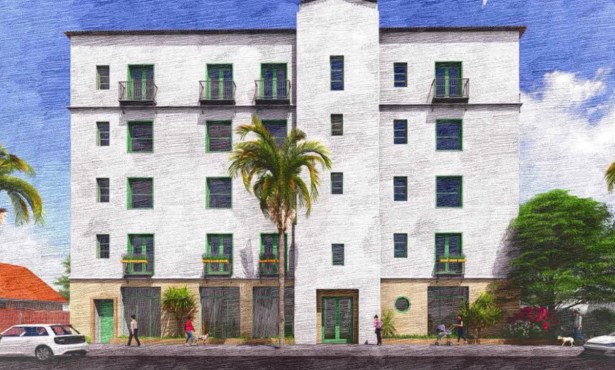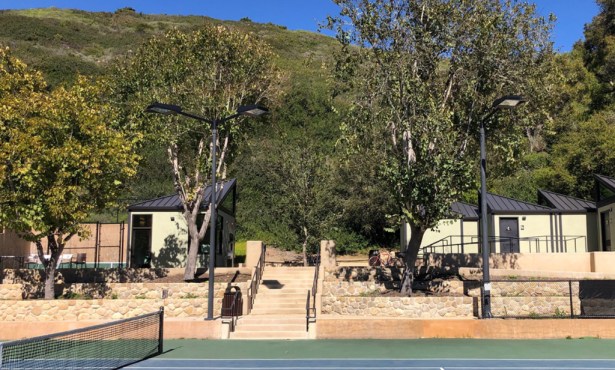A Question of Design
Dom Camardella and Santa Barbara Sound Design
Musical careers are full of turning points, some of which hold
greater relevance than others. What if John and Paul had not met at
a Liverpool church fete? What if Jeff Buckley had not gone swimming
in the Mississippi River on that fateful May evening? And what if
Halogen actually listened to me when I managed them back in
Australia? Who is Halogen, you ask? My point exactly.

For producer, engineer, and musician Dom Camardella — who these
days owns and operates the internationally renowned Santa Barbara
Sound Design studios on Haley Street — the turning point in his
career came via a chance meeting with Jim Messina. But rather than
thrusting Camardella and his band into fame and fortune, the
experience instead directed him into the realm of musical
production and, as fate should have it, a chance to make an even
greater musical impact.
After accepting an invitation from a former East Coast band mate
to join him in Santa Barbara in the mid-’70s, that friend’s
subsequent departure left Camardella musically marooned in
California. But it didn’t take long for Camardella, a keyboardist,
to cross paths with some of S.B.’s best musicians and the result
was the formation of the band Passage. Featuring such emergent
names as Randy Tico, Tony Moreno, Lorenzo Martinez, and Jeff
Elliot, Passage was soon enjoying life as the house band for
longtime music institution Baudelaire’s.
“It was at Baudelaire’s that Jim Messina discovered us,”
recalled Camardella recently. “After jamming with us for a few
weeks, we became his backup band and would eventually record a
CD — at the very studio I now own — under the name Oasis.
Unfortunately, he would first replace Randy and later replace me
and within a few months the band fell apart. We were a great band
and extremely creative. I believe we would have succeeded on our
own, but the allure of a proven rockstar was too much for the band
and he eventually took control and eliminated the people who had
power to keep the ensemble independent of his own goals.”
With the advent of the personal computer, Camardella temporarily
turned his back on music and established one of the first computer
sales companies in Santa Barbara. But when the Musical Instrument
Digital Interface (MIDI), evolved shortly thereafter, Camardella
was pulled back to music. The digital evolution in music meant his
engineering degree from MIT and technical expertise had become an
attractive proposition and, by the mid-’80s, he was working in a
recording studio. After a stint managing the facility, Camardella
purchased both the building and studio and Santa Barbara Sound
Design was born.

Dom Camardella didn’t just jump in and take over. Rather, he
used the opportunity of owning the studio to learn all aspects of
sound production, assisting in every project, and diligently
coupling his technical prowess with practical know-how. Since Santa
Barbara Sound Design always attracted major players, it was the
perfect schooling. By working with the likes of Joe Cocker and
Kenny Loggins, Camardella was afforded the opportunity to learn
from the best.
“In 1989, I finally got my break to step into the main chair,”
said Camardella. “The Maynard Ferguson Big Band was in the midst of
a new CD for Warner Brothers and their engineer had taken ill the
morning of a session. Maynard arrived and asked where the engineer
was and I said, ‘He called in sick.’ Maynard then asked if I could
handle it and at the end of the day he told me to take over.
Shortly thereafter, Higher Octave Music sent me a newly signed
flamenco artist — Ottmar Liebert — and the rest is history”
For five years, Camardella and Liebert lived the musical dream.
They delivered Higher Octave their very first Grammy nomination
before Liebert signed with Epic. Camardella continued working on
the evolution of Liebert’s sound as it opened up to myriad
tangents. Carlos Santana cameoed and a second Grammy nomination
followed suit.
The early ’90s saw the ensemble constantly touring — Camardella
spent more time on the road playing grand piano and keyboards than
he did in Santa Barbara. It wasn’t until he and Liebert went their
separate ways that he could fully concentrate his efforts upon the
studio once again.
Like any small business, Santa Barbara Sound Design has
encountered more than its fair share of ups and downs. But,
throughout its 30 years in operation, the success of the studio has
rested soundly upon its foundations — literally. When the studio
was built in the mid-’70s, it was designed to reflect the finest
facilities of Nashville, New York, or London. The acoustic
recording space — particularly the room where drums and vocals are
recorded — has always kept the studio both vital and relevant
within an ever-changing industry. And Camardella’s embracing of the
latest technologies over the years has ensured that the studio
remained state-of-the-art.
The ever-changing nature of the recording industry has recently
seen the demise of some historic studios. But the facilities that
have disappeared were larger, costly, multi-room operations, which
is partially why the more intimate confines of Sound Design are
even more in demand — 2005, in fact, was the studio’s most
successful year to date. Diversity helps too: in addition to the
musical projects, Camardella’s studio records audio for television
and feature films, and also does books on tape, which has proven to
be a valuable niche. It certainly doesn’t hurt that many mainstream
directors, actors, and authors live nearby and have come to depend
on the facility.
“Take an actor such as Rob Lowe,” explained Camardella. “He will
be out on location acting in either a movie or a television series
and there will always be some lines that need repairing. Having a
local facility where he can spend three or four hours retaking the
lines as needed and not having to commute to Los Angeles is very
reassuring. We have similarly worked with the likes of John Cleese,
and Diane Ladd, Fannie Flagg, and Jack Canfield with the occasional
visit from Michael Douglas, Dennis Miller, Dennis Franz, and even
Robert Mitchum when he was still alive. These are all celebrities
who live in our community and have come to depend upon a facility
like ours.”
On the musical side of things, location is also an important
factor in Sound Design’s continued success — Santa Barbara is a
rather enticing destination for international musicians in search
of a place to spend some working time. And with Camardella and his
team ensuring that the facility features all the tools and support
that might be required for any given project, the city itself is an
alluring destination. The fact that a quality hotels, fine
restaurants, and the beach all reside just around the corner
doesn’t hurt business either. But it is not just those from out of
town who see such virtues.
“When we originally decided that we wanted to work here in Santa
Barbara, we went around looking at the various studios that are on
hand,” said Depeche Mode’s Martin Gore while rehearsing at Sound
Design. “We simply liked this place the best. It was not just the
size of the studio or its equipment, but also its location that
played a part in the decision. When you’re recording, there is a
lot of time in the studio that you find the experience to be quite
tedious and it is good to get out and go for a walk. And if you are
in the middle of nowhere, that can be really depressing. So not
only is Santa Barbara home, it is also a very nice alternative to
experiences like that.”
Along with Depeche Mode, an array of music’s greatest have
recently visited Sound Design. Radiohead, Beck, David Crosby,
Herbie Hancock, Chick Corea, and Flora Purim and Airto have
recorded there. Yes spent three-and-a-half months tracking a new
album. After recording their last album at Sound Design, Blues
Traveler wanted to return for their subsequent recording, but was
blocked by Depeche Mode’s occupation of the studio. And, this past
spring, Live set up camp. The group had just parted ways with their
record company and was self-financing a new recording. Setting up
as Depeche Mode were moving out, the recording came out so well
that Live are now signed with Epic, which will be releasing Songs
from Black Mountain on April 11.
All of which only makes me wonder all the more about musical
turning points. What if Jim Messina had not crossed paths with Dom
Camardella and Passage had not evolved into Oasis then died way
back in the ’70s? What if Passage had followed a path to world
musical domination? Chances are that Dom Camardella would not have
entrenched himself down at Santa Barbara Sound Design, which — for
Santa Barbara, the nearby and faraway music worlds, the film and
television industries, and everything in between — would have been
a very sad turning point indeed.



